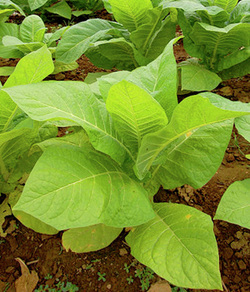Hernan Cortes by Marc B.
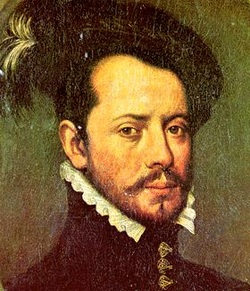
Spain has sponsored many different voyages to the New World during the age of exploration. One of the explorers that Spain funded was Hernan Cortes. Cortes did many things while over in the New World, particularly Southern America/Yucatan. Cortes’ effect on his voyage helped shaped Spain to be the most powerful country at the time, at the expense of the Aztec culture, and helped France and England to try and recreate what he accomplished.
Sent over in 1518 with 11 vessels, 500 men, and a few cannons Cortes started his first expedition into the Yucatan Peninsula. By March of 1519 he had claimed the Aztec’s land for the Spanish crown, thus securing areas for colonization and a very large supply of gold. Most of the gold was sent over to Spain, making Spain richer than most of the countries at the time. Spain then gained power through all the gold, land, and slaves that they acquired from Cortes’ domination over the Aztecs. Cortes’ contributions were important to shaping the future of Europe.
Cortes had a large list of accomplishments with his expedition into Mexico and the Yucatan, but there were consequences because of it. Cortes had all but wiped out the
Aztec civilization, and defeating Montezuma. With the defeat of the Aztecs, the remaining citizens were captured and sold as slaves back in Cortes’ homeland of Spain. Cortes’ success with the expedition helped shape even the way that France and England started to explore in different areas of the New World.
The success of Hernan Cortes was important, even outside of Spain. His success motivated the rest of Europe to start exploring in the Americas. Considering that his success in South America, he influenced England and France to start exploring a lot more in search of gold and land. The United States possibly could not have not even existed, or the area could have been colonized by a different nation. Hernan Cortes had a great effect on the world with in expedition. If he didn’t succeed, much of what we know as a country today could not have been.
Sent over in 1518 with 11 vessels, 500 men, and a few cannons Cortes started his first expedition into the Yucatan Peninsula. By March of 1519 he had claimed the Aztec’s land for the Spanish crown, thus securing areas for colonization and a very large supply of gold. Most of the gold was sent over to Spain, making Spain richer than most of the countries at the time. Spain then gained power through all the gold, land, and slaves that they acquired from Cortes’ domination over the Aztecs. Cortes’ contributions were important to shaping the future of Europe.
Cortes had a large list of accomplishments with his expedition into Mexico and the Yucatan, but there were consequences because of it. Cortes had all but wiped out the
Aztec civilization, and defeating Montezuma. With the defeat of the Aztecs, the remaining citizens were captured and sold as slaves back in Cortes’ homeland of Spain. Cortes’ success with the expedition helped shape even the way that France and England started to explore in different areas of the New World.
The success of Hernan Cortes was important, even outside of Spain. His success motivated the rest of Europe to start exploring in the Americas. Considering that his success in South America, he influenced England and France to start exploring a lot more in search of gold and land. The United States possibly could not have not even existed, or the area could have been colonized by a different nation. Hernan Cortes had a great effect on the world with in expedition. If he didn’t succeed, much of what we know as a country today could not have been.
The Columbian Exchange by Genevieve G.
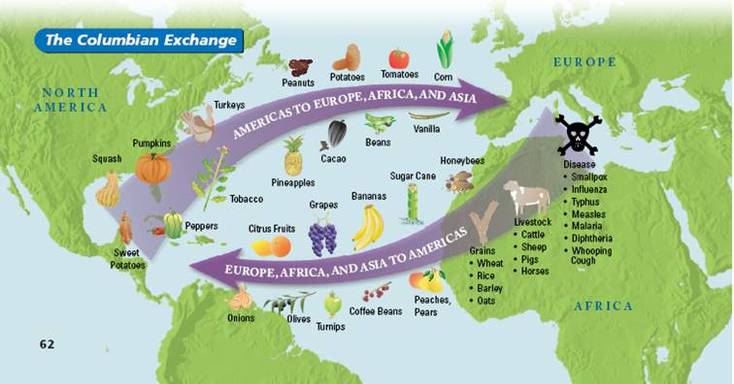
The Columbian Exchange was one of the most influential events in the shaping of what was once known as the "New World". It was the widespread exchange of animals, plants, culture, diseases, and ideas. Basically, it was one MAJOR case of cultural diffusion (and just diffusion in general) between the western and eastern hemispheres. No one could hide from the effects the the Columbian Exchange had; it didn't matter if you were a slave, peasent, or aristocrat- you were, in one way or another, influenced by it's dramatic qualities.
Both negative and positive consequences resulted from the Columbian Exchange. First off, the spread of diseases from the Old to New World, such as the Bubonic plague, chicken pox, and yellow fever, caused the population to drop between 50-90 percent from 1500-1650. Though these illnesses already occured in the eastern part of the world, people home to the Americas did not have an immunity built up to these specific ailments. Besides diseases, however, there were many positive that occured during the Columbian Exchange. For example, the spread of domesticated animals (goat, horse, cow, chicken) contraditorally caused a population increase after plauges had already run their course. Additionaly, domesticated plants (maize, potatoes, tomatoes), especially edible ones, were transfered across the Atlantic. Having more domesticated plants that could be used for agriculture had similar affects as the newly introduced animals did. Vwah-lahh! An even higher population!
Though many issues did arise due to the Columbian Exchange, it was a necessary event that not only tied the world together like never before, but helped mold the modern world. Examples of its influences can be seen at any grocery store, neighboor hood park, or even school. All in all, the Columbian Exchange was a turning point in a majority of economic systems between 1450-1750 that combines efforts from explorers, natives, and all others alike.
Both negative and positive consequences resulted from the Columbian Exchange. First off, the spread of diseases from the Old to New World, such as the Bubonic plague, chicken pox, and yellow fever, caused the population to drop between 50-90 percent from 1500-1650. Though these illnesses already occured in the eastern part of the world, people home to the Americas did not have an immunity built up to these specific ailments. Besides diseases, however, there were many positive that occured during the Columbian Exchange. For example, the spread of domesticated animals (goat, horse, cow, chicken) contraditorally caused a population increase after plauges had already run their course. Additionaly, domesticated plants (maize, potatoes, tomatoes), especially edible ones, were transfered across the Atlantic. Having more domesticated plants that could be used for agriculture had similar affects as the newly introduced animals did. Vwah-lahh! An even higher population!
Though many issues did arise due to the Columbian Exchange, it was a necessary event that not only tied the world together like never before, but helped mold the modern world. Examples of its influences can be seen at any grocery store, neighboor hood park, or even school. All in all, the Columbian Exchange was a turning point in a majority of economic systems between 1450-1750 that combines efforts from explorers, natives, and all others alike.
The Monroe Doctrine by Aheron L. L.
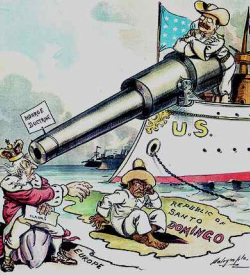
The Monroe Doctrine was introduced on December 2, 1823. It basically stated that any European efforts to colonize the land of the Americas was viewed as acts of aggression requiring U.S. intervention. The doctrine asserted that the Western Hemisphere was not to be colonized at any point. The doctrine was issued around the time most of the Latin Americas were gaining their freedom from Spain. So the doctrine was also issued because they didn't want Latin America to have to go through what they did with the Europeans. The Monroe Doctrine shaped Latin America into what it is today.
James Monroe first stated the doctrine during his State of the Union Address to Congress. The doctrine was so loved that it was one of the longest-standing tenets. Monroe didn't think that it would have an impact like it did for nearly two centuries. The doctrines primary objective was to merely keep the newly independent Latin American colonies free of European intervention. But at the same time when the doctrine was enforced, no one took it seriously because America didn't really have a creditable army until the British approved it and they had the backing of the Royal Navy.
When Latin America heard about the doctrine they were thankful but they knew that it wouldn't last against the Triple Alliance because of Americas lack of "enforcement". It wasn't until they heard the United States had backing from Great Britain that they really embraced the doctrine because now it had purpose with the proper backing to it. Although they liked the doctrine they weren't to thrilled by how the U.S. was trying to assert their dominance over them in a big brother sort of way.
Nearly 40 years later many European creditors wanted to collect debts from Latin American countries with the use of armed intervention. President Theodore Roosevelt quickly sent marines to Santo Domingo and Nicaragua. That shows that the Monroe Doctrine is in full effect and if it was never instituted then Latin America could be a lot different than what it is today.
James Monroe first stated the doctrine during his State of the Union Address to Congress. The doctrine was so loved that it was one of the longest-standing tenets. Monroe didn't think that it would have an impact like it did for nearly two centuries. The doctrines primary objective was to merely keep the newly independent Latin American colonies free of European intervention. But at the same time when the doctrine was enforced, no one took it seriously because America didn't really have a creditable army until the British approved it and they had the backing of the Royal Navy.
When Latin America heard about the doctrine they were thankful but they knew that it wouldn't last against the Triple Alliance because of Americas lack of "enforcement". It wasn't until they heard the United States had backing from Great Britain that they really embraced the doctrine because now it had purpose with the proper backing to it. Although they liked the doctrine they weren't to thrilled by how the U.S. was trying to assert their dominance over them in a big brother sort of way.
Nearly 40 years later many European creditors wanted to collect debts from Latin American countries with the use of armed intervention. President Theodore Roosevelt quickly sent marines to Santo Domingo and Nicaragua. That shows that the Monroe Doctrine is in full effect and if it was never instituted then Latin America could be a lot different than what it is today.
Tobacco First Grown by Daniel T.
Daniel T.
Period 2
1/28/10
10:00PM
Tobacco was first commercialized in South America in the year of 1612. This presented a big change for the farmers and the economy of South America. Tobacco was also possibly the first commercial plant grown in South America. With this new crop, many new opportunities opened up for South America, but it also led to many bad situations.
One of the first main uses of tobacco was for “religious visions” by shamans. The Shamans were reported to get extremely intoxicated, and would fall to the ground in a trance, and stay there for many days and nights. After awakening from these trances, they would report visions from God. This led to many religious practices involving tobacco smoke, which led to a large change in religious views that lasted for a long time.
Not everyone was for tobacco at the time, especially woman. When reports on the effects of women and tobacco started turning up, the reports were dismal. When women claimed to smoke tobacco, they got light headed. Also the tobacco became addictive at the first use, which led to later problem. This was how tobacco slowly began to destroy the people who used it.
Another trend that evolved with the commercialization of tobacco, was chewing tobacco. This was also a very big practice among spiritual leaders, who used it again, as a hallucinatory to get “visions” from god. A lot of reports today state that the spiritual leaders did not chew as much as they held it in their mouth and let the juices trickle down there throat, which still led to the same high.
With the commercialization of tobacco, it led to both the spiritual leaders to get visions from god, which led certain people to think highly of tobacco while others felt that tobacco led to more problems than helpfulness. Since the side affects that can happen to a person when using tobacco, such as the effects of woman. South Americas first commercial crop proved to be a big success, but also led to some danger in the community.
Che Guavara by Daniel T
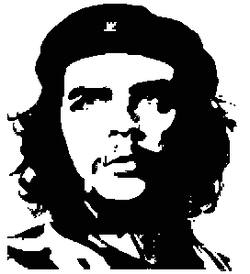
Che Guavara was an argentinian revolutionist that was born in June 14, 1928 and died tragically in Octrober 6, 1967. He was a very i mprtoant figure in Argentina, and around the world. he wsa in Time's top 100 most influential people, among various other awards. He has also had movies, books, and many other mediums describing his life.
Simon Bolivar By Laura O.
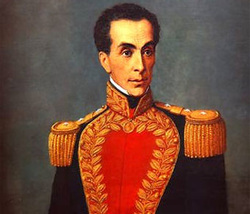
Simon Bolivar, leader of the revolt against Spain, was born in 1783, and passed away in 1830 at the age of 47. He was brought up in a wealthy family due to an previous inheritance. His family consisted of his father, his mother, his two sisters, and a brother. His father, Colonel Juan Vicente Bolivar, died when Simon was very young, in the year 1786. After his father’s death, his mother, Concepcion, took over. She took on all the responsibilities of the family, and was the educator for all of her children. Later in Simon’s life, he would fight for the independence of South America, by leading a revolt.
Simon Bolivar lost not only his father at a young age, but also his mother. At just nine years old, his mother died. Simon then lived with family that encouraged him to have a strong education. A few years later, another family member passed away, and Simon decided to run away to live with his sister and her husband, seeking a safe place. In 1799, he took a visit to spain to expand his education even more. He studied many subjects, such as literature, history, math, and french. In 1802, Simon got married to the love of his life, Maria Teresa. Sadly, she passed away a year later, and then Simon moved to Paris.
After Paris, Simon moved back to Caracas. He became a spokesperson for independence, which became official on July 5, 1811. Later, he entered into the military, and after some hard work, he became a Colonel.
Simon Bolivar was a republican creole officer. All throughout his life, he believed in independence, and would fight for it until the day he died. In Venezuela, as well as Ecuador and Columbia, Simon fought victories and was successful several times. Because of Simon’s success, a state of independence was created in South America. After Venezuela, Ecuador, and Columbia turned into separate nations, this state of independence ended.
Simon Bolivar experienced lots of pain and loss throughout his life. However, the loss of three close family members at a young age, did not prevent him from making a difference in his lifetime. He believed strongly in independence, and stayed true to his belief by fighting for the independence of his home in South America.
Simon Bolivar lost not only his father at a young age, but also his mother. At just nine years old, his mother died. Simon then lived with family that encouraged him to have a strong education. A few years later, another family member passed away, and Simon decided to run away to live with his sister and her husband, seeking a safe place. In 1799, he took a visit to spain to expand his education even more. He studied many subjects, such as literature, history, math, and french. In 1802, Simon got married to the love of his life, Maria Teresa. Sadly, she passed away a year later, and then Simon moved to Paris.
After Paris, Simon moved back to Caracas. He became a spokesperson for independence, which became official on July 5, 1811. Later, he entered into the military, and after some hard work, he became a Colonel.
Simon Bolivar was a republican creole officer. All throughout his life, he believed in independence, and would fight for it until the day he died. In Venezuela, as well as Ecuador and Columbia, Simon fought victories and was successful several times. Because of Simon’s success, a state of independence was created in South America. After Venezuela, Ecuador, and Columbia turned into separate nations, this state of independence ended.
Simon Bolivar experienced lots of pain and loss throughout his life. However, the loss of three close family members at a young age, did not prevent him from making a difference in his lifetime. He believed strongly in independence, and stayed true to his belief by fighting for the independence of his home in South America.
Change Analysis: Laura O. 1-28-11
Society: Latin America
Time Period: 1750-1914
Characteristic at beginning and end: the nations of Latin America had changed from the status of colonies to the status of independent nation states.
Political:political independence achieved in 18th/19th centuries. Political parties tried to achieve power, and many times called themselves Liberal and Conservative.
Social: social change was slow, but eventually there were significant social effects.
Religious: The role of the church was very important and was included in education.
Time Period: 1750-1914
Characteristic at beginning and end: the nations of Latin America had changed from the status of colonies to the status of independent nation states.
Political:political independence achieved in 18th/19th centuries. Political parties tried to achieve power, and many times called themselves Liberal and Conservative.
Social: social change was slow, but eventually there were significant social effects.
Religious: The role of the church was very important and was included in education.
Document Analysis: Laura O.
Source: Confronting the Hispanic Heritage: From Independence to Consolidation (page 570 World Civilizations): Bolivar's "Jamaica Letter"
Time Period: 1815, The Dawn of the Industrial Age
Author: Simon Bolivar
Society: Latin America
Purpose: to inform and warn the newspaper about federalism and dictatorship.
Tone: Inspiring, informing, lecturing
Audience: It was written for a newspaper to show his opinion on the future of Latin America.
Point of view: The point of view of Simon Bolivar's. First Person
Important content: "Americans today, and perhaps to a greater extent than ever before, who live within the Spanish system occupy a position in society no better than that of serfs destined to labor, or at best they have no more status than that of mere consumers."
Evidence of bias: It was biased, because it was an opinion of Simon Bolivar's.
Time Period: 1815, The Dawn of the Industrial Age
Author: Simon Bolivar
Society: Latin America
Purpose: to inform and warn the newspaper about federalism and dictatorship.
Tone: Inspiring, informing, lecturing
Audience: It was written for a newspaper to show his opinion on the future of Latin America.
Point of view: The point of view of Simon Bolivar's. First Person
Important content: "Americans today, and perhaps to a greater extent than ever before, who live within the Spanish system occupy a position in society no better than that of serfs destined to labor, or at best they have no more status than that of mere consumers."
Evidence of bias: It was biased, because it was an opinion of Simon Bolivar's.
Peoples Analysis: Laura O.
Name of group: Caudillos
Time Period: 1750-1914
Location: Latin America
Strengths: They dominated areas by using force. They brought their concept of rule to the national governments. It was a good thing that they had a strong military, in order to defend themselves from Spain and other threats.
Weakness: They spent a great cost on their military
Legacy: Some defended regional elites and landowners, while others were populists and defended American Indians, the poor, and peasants.
Time Period: 1750-1914
Location: Latin America
Strengths: They dominated areas by using force. They brought their concept of rule to the national governments. It was a good thing that they had a strong military, in order to defend themselves from Spain and other threats.
Weakness: They spent a great cost on their military
Legacy: Some defended regional elites and landowners, while others were populists and defended American Indians, the poor, and peasants.
Human Sacrifices by Crystal D. 1-28-11
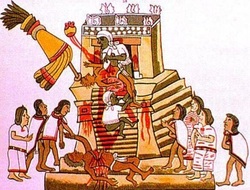
The Aztecs Empire lasted from 1300-1520. The Aztecs had strong armies, and magnificent buildings in their cities. They were known for many things such as how they used human sacrifices. The Aztecs had sacrifices on a regular basis. Sacrifices were apart of their rituals and worship to the gods.
The aztecs were worshippers of Huitzilopochtli who was a warrior god, eventually becoming the sun god. They believed that in order for the sun to rise every day that they needed to make human sacrifises to the sun. They also believed that the sun and the earth had been destroyed four times, and that they lived in its 5th sun. The Aztecs believed that the destruction of their sun and earth would soon happen, and that the they could slow it down by practicing human sacrifices.
The sacrifices were usualy done outside infront of a great pyramid. The way that they would sacrifice people for the sun god, Huitzilopochtli, was for the priest to get a knife and cut under the rib cage, of the person removing their heart. The heart would then be held up to the sky, then later burned, and the body would be thrown down the temple stairs. The ceramonies for each god were different. Some of them required a male while others used females.
All sorts of people would be sacrificed, such as the citizens, or the enemies of the empire. Sometimes they would hold a xochiyaoyotl. This was a small war were both sides were required to fight. The wars weren't to try to kill people, it was a way of capturing people to later use as sacrafices. The people participating in the fights usually chose to do it themselfs.
The reason for the Aztecs sacraficing people is that they believed that the world was controled by divine forces. They believed that with sacrafices they could keep the forces in balance. These forces were their gods, and the Aztecs had gods for many different things. The Aztecs sacrificed a number of people each year.
The aztecs were worshippers of Huitzilopochtli who was a warrior god, eventually becoming the sun god. They believed that in order for the sun to rise every day that they needed to make human sacrifises to the sun. They also believed that the sun and the earth had been destroyed four times, and that they lived in its 5th sun. The Aztecs believed that the destruction of their sun and earth would soon happen, and that the they could slow it down by practicing human sacrifices.
The sacrifices were usualy done outside infront of a great pyramid. The way that they would sacrifice people for the sun god, Huitzilopochtli, was for the priest to get a knife and cut under the rib cage, of the person removing their heart. The heart would then be held up to the sky, then later burned, and the body would be thrown down the temple stairs. The ceramonies for each god were different. Some of them required a male while others used females.
All sorts of people would be sacrificed, such as the citizens, or the enemies of the empire. Sometimes they would hold a xochiyaoyotl. This was a small war were both sides were required to fight. The wars weren't to try to kill people, it was a way of capturing people to later use as sacrafices. The people participating in the fights usually chose to do it themselfs.
The reason for the Aztecs sacraficing people is that they believed that the world was controled by divine forces. They believed that with sacrafices they could keep the forces in balance. These forces were their gods, and the Aztecs had gods for many different things. The Aztecs sacrificed a number of people each year.

